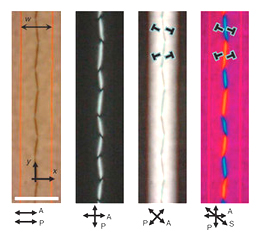Research Abstract
マイクロリンクルの溝中のネマチック液晶におけるジグザグ状線欠陥およびコロイドの操作
Zigzag line defects and manipulation of colloids in a nematic liquid crystal in microwrinkle grooves
2012年2月28日 Nature Communications 3 : 701 doi: 10.1038/ncomms1709

空間的に閉じ込められた液晶は、非一様な配向を示し、与えられた境界条件や形状に応じた非自明な構造を持つ自己組織的に形成されたトポロジカル欠陥を伴うことが多い。今回我々は、ネマチック液晶を正弦曲線状のマイクロリンクルの溝に閉じ込めると、液晶ツイスト変形の周期的配列構造と共にジグザグ線欠陥が生じることを新たに発見した。この周期的秩序化は、液晶に固有な弾性の異方性と、平坦な液晶-空気界面および曲面状の液晶-溝界面からなる非一様状態を生み出す境界条件に起因している。溝の形状もしくは分子キラリティーを制御することによってその周期構造を調節できることから、トポロジカル欠陥構造を設計するうえでその境界条件と非対称性の設定が重要になる。そのうえ、ジグザグ欠陥のキンクは微粒子を捕捉できるため、この性質を利用すれば新しいコロイド操作方法が得られるかもしれない。容易に作製可能なマイクロリンクル溝を用いたこの系は、制御可能な欠陥の配列を利用した新しい微細加工方法を提供するものである。
- 産業技術総合研究所(AIST)ナノシステム研究部門(NRI)
Spatially confined liquid crystals exhibit non-uniform alignment, often accompanied by self-organised topological defects of non-trivial shape in response to imposed boundary conditions and geometry. Here we show that a nematic liquid crystal, when confined in a sinusoidal microwrinkle groove, exhibits a new periodic arrangement of twist deformations and a zigzag line defect. This periodic ordering results from the inherent liquid crystal elastic anisotropy and the antagonistic boundary conditions at the flat liquid crystal–air and the curved liquid crystal–groove interfaces. The periodic structure can be tuned by controlling the groove geometry and the molecular chirality, which demonstrates the importance of boundary conditions and introduced asymmetry for the engineering of topological defects. Moreover, the kinks in the zigzag defects can trap small particles, which may afford a new method for manipulation of colloids. Our system, which uses easily fabricated microwrinkle grooves, provides a new microfabrication method based on the arrangement of controllable defects.

